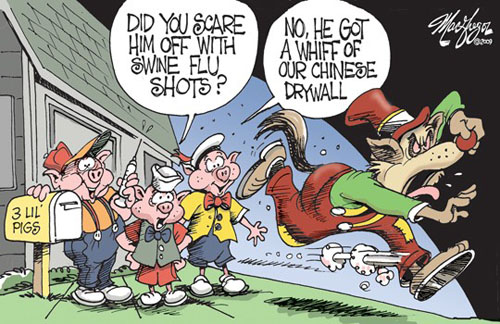
Cartoon by Douglas MacGregor, The News-Press.
June 20, 2011
I first became aware of the problem of toxic drywall manufactured in China during my 2010 visit to New Orleans. Many homeowners rebuilt their homes after Hurricane Katrina in August 2005, and Hurricane Rita in September 2005 using Chinese drywall. This drywall made occupants sick, corroded metal fixtures, and rendered homes unfit to live in. Homeowners had to tear out the drywall, corroded wiring, fixtures, etc.
About 700 to 1,000 New Orleans families were affected. These hurricane victims suffered the initial trauma of damage to their homes, fixed up their damaged homes, and then faced the cost of removing Chinese drywall and corroded wiring. To add insult to injury, many of these homeowners had their claims denied by insurance companies because of insurance policy exclusions.
As much as 250 million board feet of this Chinese drywall came into the United States through West Coast ports, including Oakland, Long Beach, and Seattle. Chinese drywall is believed to have been imported in the U.S. since at least 2001 when a building boom and a busy hurricane season caused a domestic drywall shortage that lasted up to 2008. Much of the Chinese drywall was also used to rebuild Louisiana homes damaged by Hurricane Rita. Chinese drywall has been discovered in Virginia, Alabama, Mississippi and California.
According to the U.S. Consumer Product Safety Commission (CPSC), homeowners in 26 states have filed numerous complaints with the agency. It is estimated that between 60,000 and 100,000 homes and commercial properties across the United States were made from this material.
In a May 25, 2010 press release, the CPSC identified the drywall manufacturers whose drywall emitted high levels of hydrogen sulfide in testing conducted for the agency by Lawrence Berkeley National Laboratory. All of the manufacturers are located in China. The CPSC press release stated that there is a strong association between hydrogen sulfide and metal corrosion. Some of the Chinese drywall had emission rates of hydrogen sulfide 100 times greater than non-Chinese drywall samples. The CPSC is is trying to persuade Chinese companies to pay for the repairs.
Homeowners complained of a rotten egg smell in their homes and condominiums. The cause of this foul smelling odor is now known to be caused by gases emitted from the defective Chinese drywall, which can cause significant damage to HVAC (Heating, Ventilation, and Air Conditioning), smoke detectors, electrical wiring, metal plumbing components, and other household appliances. The gases permeate homes and can cause asthma-like symptoms, eye irritation, bloody or runny noses, headaches, sore throats, nausea, insomnia, and irritability.
As the manufacturers are located in China, pending litigation names U.S. suppliers as defendants. Seifart v. Banner Supply Company, 11th Judicial District of Florida, was the nation’s first Chinese drywall case to go to trial. The plaintiffs, a Florida family were forced out of their home by foul odors and toxic fumes. In June 2010, the jury found Miami-based Banner Supply liable on the grounds of negligence, public nuisance and violation of Florida’s Deceptive and Unfair Trade Practices Act and awarded the family $2.47 million. The trial is a bellwether for about 1,000 lawsuits in the Florida courts, as well as 5,000 suits filed in federal court that have been consolidated in multi-district litigation in the U.S. District Court for the Eastern District of Louisiana.
In the multi-district litigation, In re: Chinese- Manufactured Drywall Products Liability Litigation, MDL No. 2047 (E.D. La.), Banner Supply Co., insurers, and homeowners agreed in a court filing on June 14, 2011, to a $55 million settlement of claims that the corrosive product damaged homes, all or nearly all of them in Florida. The proposed settlement, which requires approval from U.S. District Judge Eldon Fallon in New Orleans, would resolve claims by thousands of plaintiffs against Banner Supply Co., several related companies and Banner’s insurers. The settlement, however, covers just a portion of the claims by homeowners. Judge Fallon is presiding over more than 10,000 claims by residents blaming damage to their homes on Chinese drywall, which was used in construction throughout Florida and the Gulf Coast.
Banner claimed it did not know the drywall was defective. Yet, Banner knew by October 2006 that builders were complaining about odors from the drywall, yet continued to sell it. Banner also allegedly entered into a confidential agreement with Knauf, one of the Chinese manufacturers, in early early 2007 that called for Knauf to replace about 44,000 pieces of its drywall with a domestic product.
Judge Fallon in the Banner case also ruled invalid some, but not all, the policy exclusions relied on by insurance companies to deny coverage for toxic Chinese drywall.
With the Seifert jury verdict against a Chinese drywall supplier and the Banner settlement, I would expect a flood of settlements in the remaining pending cases and cases to come.
More Info
The Florida Department of Health has developed a self-assessment guide to make it easier for homeowners to determine if their home meets the criteria for a possible case of drywall associated corrosion


 The Hunger Site
The Hunger Site
No Comments
Comments for The Toxic Chinese Drywall Controversy are now closed.